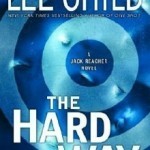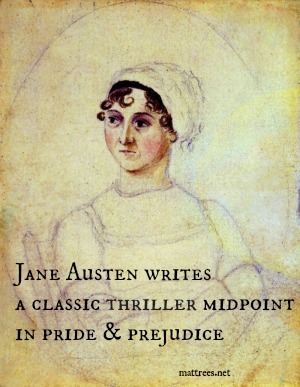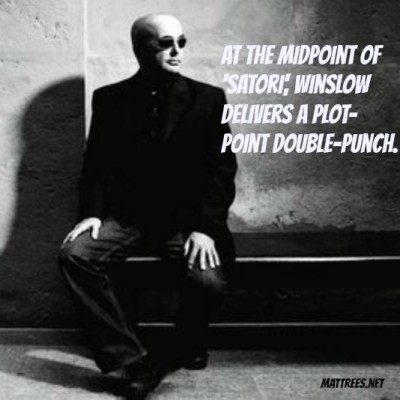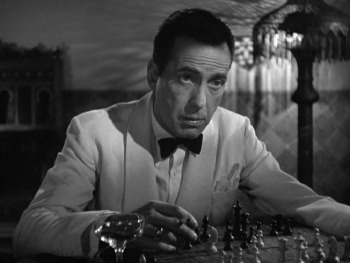Matt Rees's Blog - Posts Tagged "jane-austen"
Why thriller titles...aren't
 Thriller titles often seem designed to confuse prospective readers. Pick up a book by a well-known author, read the title which is something like “Better Off Dead,” and you’re likely to think: “Did I already read that one?
Thriller titles often seem designed to confuse prospective readers. Pick up a book by a well-known author, read the title which is something like “Better Off Dead,” and you’re likely to think: “Did I already read that one?It seems to me titles in the thriller world have moved away from any kind of descriptive or even tangential link to the plot or characters of the book. They have become in many cases an adjunct to the cover design. A “blurb” (the laudatory comments dashed all over the jacket by other writers or reviewers) distilled to two or three words. As though the title were only there as encouragement to a purchase, rather than being part of the book itself.
There are plenty of examples among today’s top writers. But let’s take the example of Lee Child’s excellent Jack Reacher novels. I just caught up on a couple I’d missed. They’re called “Without Fail” and “Nothing to Lose.”
“Without Fail” is about a plot to assassinate the Vice President of the US. I couldn’t tell you why it’s called “Without Fail.” As far as I remember, no one says “without fail” or tells Reacher he has to do something “without fail.” He drinks coffee at every opportunity – without fail, you might say – but I don’t think that’s why Child called the book “Without Fail.”
In “Nothing to Lose” Reacher finds himself in rural Colorado investigating a dead body he stumbles across in the desert. I was left unsure which of the characters had “nothing to lose.” Perhaps it was Reacher, or the people (no spoilers here) who turn out to be involved in the thing he’s investigating. Or maybe it’s the reader in the airport bookshop…
In any case, these latest two come on the back of my earlier Reacher reading, where I pondered why “Running Blind” was called “Running Blind” (despite the tagline on the cover which said something like, “Reacher doesn’t know what the hells’ going on, in fact he’s RUNNING BLIND”. Even though Reacher seemed to know what was going to happen in that book a long time before everyone else.) I still don’t know why “Worth Dying For” was called “Worth Dying For,” because Reacher never seems about to die and the people who actually die do so for despicable reasons that aren’t worth dying for.
“61 Hours” was called “61 Hours” because it took the form of a countdown. But why 61 hours? Pretty arbitrary, but at least when I stand before a shelf of Child books in a store I’m able to remember that I’ve read that one. Otherwise I get confused. It’s almost as though publishers want thrillers to have such vague titles that befuddled readers will buy the same book twice.
My novels have titles related to the theme or events or characters of the book. If you’re looking at a shelf of my books and you’ve read some of them, you’ll recall that “A Grave in Gaza” was the one set in Gaza; that “The Collaborator of Bethlehem” was about a collaborator and was set in Bethlehem. “The Samaritan’s Secret” was about a secret held by a Samaritan. If you haven’t read “The Fourth Assassin,” you’ll run mentally through the books you have read and think: “They didn’t have four assassins in them, but this one does, so I haven’t read it yet. Let’s buy it.” And you wouldn’t come to the end of the book saying to yourself: “Hey, I only counted three assassins,” or “Hey, there weren’t any assassins in the book at all. Were there?”
Read the rest of this post on my blog The Man of Twists and Turns.
Published on September 08, 2011 04:00
•
Tags:
charles-dickens, crime-fiction, franza-kafka, greg-iles, jane-austen, joseph-heller, lee-child, leo-tolstoy, thrillers, titles
How to write a Midpoint that gives new impetus to your plot
The Midpoint is key to the pace of a thriller -- and many other genres
By Matt Rees
When you plot a novel, pay special attention to the plot point called the Midpoint. Write a good Midpoint and you’ll propel your readers into the second half of your book with spectacular impetus.
What is the Midpoint? It falls directly in the center of the story structure (which may not be precisely in the middle of the book by page number, but probably is close.) The Midpoint is a scene that shifts the context and momentum of the story. It could be big or small. It could shift the story 45 degrees or 180. But it absolutely must push the story up a gear or two.
The main result of the Midpoint is a change in the hero. In the first half of Act II, the hero reacts to the situation around him. At the Midpoint, the hero becomes an action figure, powering through the second half of Act II in a more proactive mode.
 Jane Austen, thriller novelist
Jane Austen, thriller novelist
That doesn’t mean this only works for action heroes. That master of the thriller genre Jane Austen writes a classic Midpoint in Pride and Prejudice, when Mister D’Arcy proposes to Lizzie Bennett, only for her to reject him and tell him she hates all he stands for. After that, there’s no more dancing around each other, no coming together just because we like Lizzie and want her to marry a nice, rich guy. They have to act, or they aren’t going to end up as a couple.
Imagine your novel as a ship (at least, a ship contemporary to Miss Austen). The Midpoint is the mainmast, while the first and second plot points are the foremast up front and the mizzen at the back. Sure, there are ships with only two masts. But they don’t move as fast or as powerfully as a ship that’s built around a big, impressive, driving mainmast. Novels without a mainmast won’t move as quickly either, no matter how much wind the author supplies.
Midpoint story structure checklist
Here are a few ways to build a Midpoint that propels the hero into the second half of Act II with major momentum:
• Introduce a new character whose presence adds to the danger. In Gorky Park, Martin Cruz Smith gives his detective a new American pal who turns out to have a big impact on the denouement.

• Change the nature of the threat to the hero. Don Winslow does this in Satori and gives us a 180 degree twist. The reader spends the first half of the book thinking the hero has to carry out a hit for the CIA to buy his freedom from a US military jail. Instead, at the Midpoint, Winslow delivers a plot-point double punch. The hero kills his target — at great risk and with much tension. Only to have the CIA immediately try to kill him. For the rest of the book, he faces entirely unexpected risks as he figures out why he was double-crossed and goes after the men he believes did it.
• Introduce new information. Bridget Jones learns her boyfriend Mark is involved with another woman in Bridget Jones’s Diary. Jack Reacher finds reason to suspects the woman he’s involved with might be the killer in The Affair.
• Kill someone, to heighten the element of danger and provide a new impetus for the hero’s chase. I admit I like this one. I’ve used it in several of my novels. In Mozart’s Last Aria, the great composer’s sister is about to learn who killed him, only for her informant to be murdered during a performance of “The Magic Flute.” She’s back to square one, but now she’s sure there’s a murderer and that he’s onto her.
The show 24 tends to use the 180-degree Midpoint, too. Ever noticed how Jack Bauer fights one lot of bad guys for the first 12 hours, only to realize halfway through the season that the real bad guy is someone else entirely with a completely different plan?
What does a good Midpoint do?
A good Midpoint moves the plot faster. But best of all the reader experiences the same startling shift in focus as the hero. That creates tension and conflict. Which is a good thing in any plot. It’s also a way of saying to the reader, “Gotcha. Stay tuned, because I have more like that for Act III.”
Always try to make the Midpoint blow your readers away. Devote as much energy and ingenuity to it as you do to the set-up of the novel. Never make it so subtle it passes unnoticed. Think of The Da Vinci Code. The Midpoint of Dan Brown's novel is the discovery of what the Holy Grail really is. That’s pretty earth-shattering, even as Midpoints go.
Got a clock? Find the Midpoint
 Screenwriters tend to be particularly precise about having their Midpoint land exactly 50 percent of the way through the movie. Midpoint-spotting in movies is, therefore, pretty easy (provided you own a clock) and can be very instructive as a plot exercise.
Screenwriters tend to be particularly precise about having their Midpoint land exactly 50 percent of the way through the movie. Midpoint-spotting in movies is, therefore, pretty easy (provided you own a clock) and can be very instructive as a plot exercise.
Check out Casablanca. At the exact middle of the movie, Rick harshes out at Ilsa. She runs off. He's left in the bar thinking about what a terrible man he has become. Which propels him to spend the second half of the movie redeeming himself.
Let me know if there's a great Midpoint that I haven't mentioned.

Get a FREE ebook of my crime stories.
By Matt Rees
When you plot a novel, pay special attention to the plot point called the Midpoint. Write a good Midpoint and you’ll propel your readers into the second half of your book with spectacular impetus.
What is the Midpoint? It falls directly in the center of the story structure (which may not be precisely in the middle of the book by page number, but probably is close.) The Midpoint is a scene that shifts the context and momentum of the story. It could be big or small. It could shift the story 45 degrees or 180. But it absolutely must push the story up a gear or two.
The main result of the Midpoint is a change in the hero. In the first half of Act II, the hero reacts to the situation around him. At the Midpoint, the hero becomes an action figure, powering through the second half of Act II in a more proactive mode.
 Jane Austen, thriller novelist
Jane Austen, thriller novelistThat doesn’t mean this only works for action heroes. That master of the thriller genre Jane Austen writes a classic Midpoint in Pride and Prejudice, when Mister D’Arcy proposes to Lizzie Bennett, only for her to reject him and tell him she hates all he stands for. After that, there’s no more dancing around each other, no coming together just because we like Lizzie and want her to marry a nice, rich guy. They have to act, or they aren’t going to end up as a couple.
Imagine your novel as a ship (at least, a ship contemporary to Miss Austen). The Midpoint is the mainmast, while the first and second plot points are the foremast up front and the mizzen at the back. Sure, there are ships with only two masts. But they don’t move as fast or as powerfully as a ship that’s built around a big, impressive, driving mainmast. Novels without a mainmast won’t move as quickly either, no matter how much wind the author supplies.
Midpoint story structure checklist
Here are a few ways to build a Midpoint that propels the hero into the second half of Act II with major momentum:
• Introduce a new character whose presence adds to the danger. In Gorky Park, Martin Cruz Smith gives his detective a new American pal who turns out to have a big impact on the denouement.

• Change the nature of the threat to the hero. Don Winslow does this in Satori and gives us a 180 degree twist. The reader spends the first half of the book thinking the hero has to carry out a hit for the CIA to buy his freedom from a US military jail. Instead, at the Midpoint, Winslow delivers a plot-point double punch. The hero kills his target — at great risk and with much tension. Only to have the CIA immediately try to kill him. For the rest of the book, he faces entirely unexpected risks as he figures out why he was double-crossed and goes after the men he believes did it.
• Introduce new information. Bridget Jones learns her boyfriend Mark is involved with another woman in Bridget Jones’s Diary. Jack Reacher finds reason to suspects the woman he’s involved with might be the killer in The Affair.
• Kill someone, to heighten the element of danger and provide a new impetus for the hero’s chase. I admit I like this one. I’ve used it in several of my novels. In Mozart’s Last Aria, the great composer’s sister is about to learn who killed him, only for her informant to be murdered during a performance of “The Magic Flute.” She’s back to square one, but now she’s sure there’s a murderer and that he’s onto her.
The show 24 tends to use the 180-degree Midpoint, too. Ever noticed how Jack Bauer fights one lot of bad guys for the first 12 hours, only to realize halfway through the season that the real bad guy is someone else entirely with a completely different plan?
What does a good Midpoint do?
A good Midpoint moves the plot faster. But best of all the reader experiences the same startling shift in focus as the hero. That creates tension and conflict. Which is a good thing in any plot. It’s also a way of saying to the reader, “Gotcha. Stay tuned, because I have more like that for Act III.”
Always try to make the Midpoint blow your readers away. Devote as much energy and ingenuity to it as you do to the set-up of the novel. Never make it so subtle it passes unnoticed. Think of The Da Vinci Code. The Midpoint of Dan Brown's novel is the discovery of what the Holy Grail really is. That’s pretty earth-shattering, even as Midpoints go.
Got a clock? Find the Midpoint
 Screenwriters tend to be particularly precise about having their Midpoint land exactly 50 percent of the way through the movie. Midpoint-spotting in movies is, therefore, pretty easy (provided you own a clock) and can be very instructive as a plot exercise.
Screenwriters tend to be particularly precise about having their Midpoint land exactly 50 percent of the way through the movie. Midpoint-spotting in movies is, therefore, pretty easy (provided you own a clock) and can be very instructive as a plot exercise.Check out Casablanca. At the exact middle of the movie, Rick harshes out at Ilsa. She runs off. He's left in the bar thinking about what a terrible man he has become. Which propels him to spend the second half of the movie redeeming himself.
Let me know if there's a great Midpoint that I haven't mentioned.

Get a FREE ebook of my crime stories.
Published on April 09, 2014 01:09
•
Tags:
casablanca, crime-fiction, historical-fiction, how-to-write, jane-austen, midpoint, story-structure, thrillers, writing-tips



